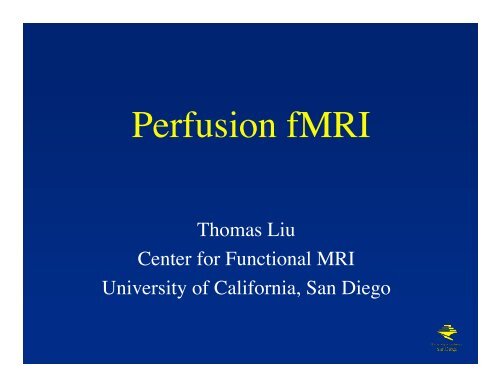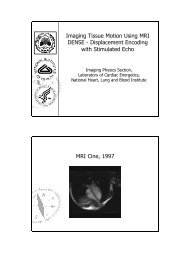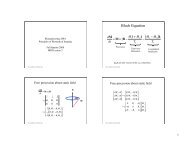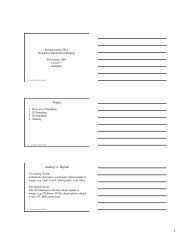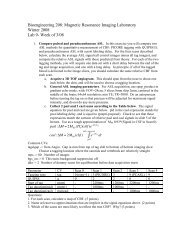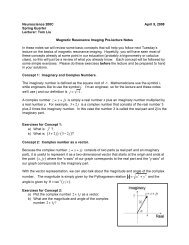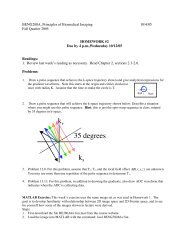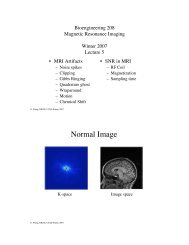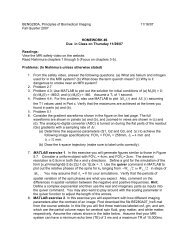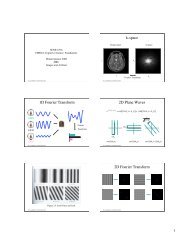Perfusion fMRI - Center for Functional MRI
Perfusion fMRI - Center for Functional MRI
Perfusion fMRI - Center for Functional MRI
Create successful ePaper yourself
Turn your PDF publications into a flip-book with our unique Google optimized e-Paper software.
<strong>Perfusion</strong> <strong>f<strong>MRI</strong></strong><br />
Thomas Liu<br />
<strong>Center</strong> <strong>for</strong> <strong>Functional</strong> <strong>MRI</strong><br />
University of Cali<strong>for</strong>nia, San Diego
Outline<br />
• Cerebral Blood Flow (CBF)<br />
• Arterial Spin Labeling (ASL) Techniques<br />
• Data Processing<br />
• Applications of ASL
Cerebral Blood Flow (CBF)<br />
CBF = <strong>Perfusion</strong><br />
= Rate of delivery of arterial blood to a<br />
capillary bed in tissue.<br />
Units:<br />
(ml of Blood)<br />
(100 grams of tissue)(minute)<br />
Typical value is 60 ml/(100g-min) or<br />
60 ml/(100 ml-min) = 0.01 s -1 , assuming<br />
average density of brain equals 1 gm/ml
Courtesy of Rick Buxton
High CBF<br />
Low CBF<br />
Time
Arterial Spin Labeling<br />
•Magnetically tag inflowing arterial blood<br />
•Wait <strong>for</strong> tagged blood to flow into imaging slice<br />
•Acquire image of tissue+tagged blood<br />
•Apply control pulse that doesn’t tag blood<br />
•Acquire control image of tissue<br />
•Control image-tag image = blood image
Methods <strong>for</strong> Tagging Arterial Blood<br />
•Spatially Selective ASL (SS-ASL) methods tag<br />
arterial blood in a region that is proximal to the<br />
imaging region of interest.<br />
• Continuous ASL (CASL) -- continuously<br />
tags blood as it passes through a thin<br />
tagging plane<br />
• Pulsed ASL (PASL) -- tags blood in a large<br />
slab proximal to imaging slice.<br />
•Velocity Selective ASL (VS-ASL) tags arterial<br />
blood based on its velocity, and takes advantage<br />
of the fact that blood decelerates as it enters the<br />
capillaries and accelerates as it enters the veins.
Arterial Spin Labeling (ASL)<br />
1:<br />
Wait<br />
Tag by Magnetic Inversion<br />
Acquire image<br />
2:<br />
Wait<br />
Control<br />
Acquire image<br />
Courtesy of Wen-Ming Luh<br />
Control - Tag µ CBF
Arterial Spin Labeling (ASL)<br />
• water protons as freely diffusible tracers<br />
Mz(blood)<br />
imaging slice<br />
alternative<br />
inversion<br />
control<br />
tag<br />
DM<br />
t<br />
Courtesy of Wen-Ming Luh
Continuous ASL<br />
tagging plane<br />
Tag duration ~ 2000 ms<br />
Pulsed ASL<br />
tagging region ~ 10 cm<br />
Tag duration ~ 15 ms<br />
Adapted from Wen-Ming Luh
Continuous ASL<br />
Imaging<br />
Plane<br />
Inversion<br />
Planes<br />
Blood<br />
Magnetization<br />
B 0<br />
Tag<br />
Conventional<br />
Control<br />
Amplitude<br />
Modulated<br />
Control
Conventional Pulsed ASL<br />
imaging slice<br />
presaturation slice<br />
tag<br />
control<br />
off-resonance IR pulse<br />
EPISTAR<br />
Courtesy of Wen-Ming Luh<br />
FAIR<br />
PICORE
Multislice CASL and PICORE<br />
CASL<br />
PICORE<br />
QUIPSS II
CASL vs. PASL<br />
• Inherent SNR <strong>for</strong> CASL is higher, but SNR/time<br />
is roughly the same.<br />
• Temporal resolution <strong>for</strong> PASL slightly better (2 s<br />
TR vs. 3 s TR).<br />
• PASL amenable to use of a presaturation pulse <strong>for</strong><br />
simultaneous CBF/BOLD.<br />
• CASL may be better <strong>for</strong> lower slices when using a<br />
head coil <strong>for</strong> transmit.<br />
• Both have non-quantitative variants that are useful<br />
<strong>for</strong> mapping.<br />
• CASL has higher SAR requirements.
Major Sources of Error <strong>for</strong> ASL<br />
• Transit Delays<br />
• Bolus Width in PASL<br />
• Relaxation Effects - different relaxation<br />
rates <strong>for</strong> blood and tissue, time of<br />
exchange.<br />
• Intravascular signal -- blood destined to<br />
perfuse more distal slices.
Controlling <strong>for</strong> Transit Delays in CASL<br />
Tagging Plane<br />
A B A B<br />
time<br />
Voxels A and B have the same CBF, but voxel B<br />
will appear to have lower CBF if the measurement is<br />
made too early.
Arterial Bolus Width<br />
CASL<br />
Baseline<br />
Global flow<br />
increase<br />
Temporal Width of<br />
bolus determined by<br />
the pulse sequence<br />
PASL<br />
Baseline<br />
Global flow<br />
increase<br />
time<br />
Temporal Width of<br />
bolus determined by<br />
arterial velocity<br />
and size of tagging<br />
slab. Underestimates<br />
global flow changes.
Defining Bolus Width in PASL (QUIPSS II)<br />
Tag the<br />
spins<br />
Saturate<br />
spins still<br />
in the slab<br />
Bolus temporal<br />
width = TI 1<br />
TI 1 TI 1
Velocity Selective ASL<br />
•Velocity selective radio-frequency pulse trains<br />
were introduced by Norris and Schwarzbauer in<br />
1999.<br />
•Velocity Selective ASL (VS-ASL) uses a velocity<br />
selective pulse train to tag blood that is flowing<br />
faster than a desired cut-off velocity (Wong et al.<br />
2002).<br />
•A typical cut-off velocity is 1 cm/s which<br />
corresponds to arterioles of about 50 µm.<br />
•Essentially eliminates the problem of transit<br />
delays.
Velocity Distribution<br />
0.1 1 10<br />
Velocity (cm/s)
Ideal Velocity Selective ASL<br />
1<br />
Control<br />
M z<br />
Image<br />
0 Tag<br />
{<br />
Physiological<br />
Motion<br />
0.1 1 10<br />
Velocity (cm/s)
Spatial Localization<br />
VENC of 0.5-2cm/s dephases spins<br />
in 20-50um arterioles
Initial Implementation (2002)<br />
90 x 180 y -90 x<br />
Tag Time<br />
SPIRAL<br />
READOUT<br />
M z<br />
1<br />
-1<br />
0<br />
•Plug flow<br />
•Laminar flow<br />
Velocity
Results - Tag Time Dependence<br />
Non<br />
Quantitative<br />
Quantitative<br />
Tag Time (ms): 700 800 1100 1300
Results - VENC Dependence<br />
VENC (cm/s): 0.5 1.0 2.0<br />
Approximate<br />
Vessel Size (um): 20 30 50
Results - Multislice VS-ASL<br />
Non<br />
Quantitative<br />
Quantitative
Future Development of VS-ASL<br />
• Better velocity selective pulses should improve<br />
motion insensitivity and quantitation of CBF<br />
(Abstract #2181 at this meeting)<br />
Velocity Profile<br />
of Initial<br />
Implementation<br />
Velocity Profile of<br />
Hyperecho based<br />
sequencewith<br />
adiabatic pulses
ASL Data Processing<br />
• CBF = Control - Tag<br />
• A CBF time series is <strong>for</strong>med from a running<br />
subtraction of Control and Tag images --<br />
pairwise subtraction, etc. .<br />
• BOLD weighting of CBF signal is small and<br />
can be minimized with short echo time<br />
acquisitions (e.g. spiral or partial Fourier) or<br />
spin-echo acquisitions.<br />
• Use of subtraction makes CBF signal<br />
insensitive to low-frequency drifts.
Pairwise subtraction example<br />
Control Tag<br />
+1 -1 +1
Running subtraction<br />
T A = 1 to 4 seconds<br />
Control Tag Control TagControl<br />
TagControl<br />
+1/2 -1<br />
+1/2 -1/2 1 -1/2<br />
<strong>Perfusion</strong> Time Series
ASL Data Processing<br />
• BOLD = average of Control + Tag images<br />
• BOLD time series is <strong>for</strong>med from the running<br />
average of Control and Tag images.<br />
• If a presaturation pulse is used, flow<br />
weighting of BOLD signal is minimized.
Simultaneous Flow and BOLD<br />
PERFUSION<br />
UNREGISTERED<br />
BOLD<br />
UNREGISTERED<br />
BOLD<br />
REGISTERED
Simultaneous Flow and BOLD with PASL<br />
Anatomy<br />
Flow<br />
change<br />
BOLD<br />
change
Event-related <strong>Perfusion</strong> <strong>f<strong>MRI</strong></strong><br />
Stimulus<br />
ASL Measurement<br />
Control<br />
Tag<br />
Periodic<br />
T A = 2 to 4 s<br />
Random<br />
T S = 1 second<br />
Goal: Estimate the<br />
Hemodynamic<br />
Response
Event-related ASL<br />
• ASL time series = tag time series interleaved with<br />
control time series<br />
• Tag and control time series are analyzed<br />
separately.<br />
• Tag and control time series are acquired at a<br />
reduced sampling rate, i.e. they are downsampled.<br />
• Can analyze with a general linear model (GLM)<br />
with downsampling matrices to reflect the fact that<br />
tag and control are interleaved.
GLM <strong>for</strong> ASL Experiments<br />
y tag = D tag Xh tag + Sb tag + n<br />
y con = D con Xh con + Sb con + n<br />
Downsampling<br />
Matrices<br />
Estimates<br />
^ ^ ^<br />
h perf = h con - h tag<br />
^ ^ ^<br />
h BOLD = h con + h tag
Results<br />
Direct<br />
Running<br />
Subtraction
Motion Sensitivity<br />
Periodic<br />
Random<br />
Control<br />
Tag<br />
Ideal<br />
Direct<br />
Estimate<br />
Running<br />
Subtraction<br />
Estimate<br />
1001<br />
1000.8<br />
1000.6<br />
1000.4<br />
1000.2<br />
1000<br />
999.8<br />
0 50 100 150 200 250<br />
0.6<br />
0.5<br />
0.4<br />
0.3<br />
0.2<br />
0.1<br />
0<br />
0 5 10<br />
Seconds<br />
15 20<br />
1002<br />
1001.5<br />
1001<br />
1000.5<br />
1000<br />
999.5<br />
0 50 100 150 200 250<br />
0.6<br />
0.5<br />
0.4<br />
0.3<br />
0.2<br />
0.1<br />
0<br />
0 5 10<br />
Seconds<br />
15 20
Non-quantitative ASL<br />
• ASL signal reflects delivery of blood to capillary<br />
beds, so it is more localized than BOLD.<br />
• Quantitative ASL has lower temporal resolution<br />
and lower CNR when compared to BOLD.<br />
• If quantitation of CBF is not necessary, then nonquantitative<br />
ASL can be used achieve better<br />
temporal resolution and higher CNR.<br />
• Techniques:<br />
• Turbo-ASL<br />
• Close-tag CASL
Turbo ASL<br />
Tag<br />
Tag<br />
Image<br />
Control<br />
Control<br />
Image<br />
Tag<br />
Tag<br />
TI<br />
TR ~ 2s<br />
Control<br />
Conventional ASL,<br />
TR > TI<br />
Control<br />
Image<br />
Tag<br />
Image<br />
Control<br />
Image<br />
Tag<br />
Image<br />
TI<br />
TR ~ 1s<br />
Turbo ASL,<br />
TR < TI
Finger Tapping<br />
PICORE<br />
Turbo<br />
PICORE
Finger Tapping<br />
Turbo PICORE<br />
|r|>0.3<br />
(twice as many<br />
points)<br />
PICORE<br />
|r|>0.42<br />
(same significance)<br />
PICORE<br />
|r|>0.36<br />
(same # of pixels)
Amplifying Transit Delays Effects in CASL<br />
Tagging Plane<br />
Baseline<br />
Signal<br />
Activation<br />
Signal<br />
Baseline<br />
Signal<br />
Activation<br />
Signal<br />
Acquiring the signal at an earlier TI amplifies the<br />
difference between the activated state and the<br />
baseline state.<br />
time
Close Tag CASL<br />
• CASL with tagging plane<br />
1cm from imaging slice<br />
• Control is CASL tag on<br />
opposite side of slice<br />
• Tag duration 700ms<br />
• Delay to image 200ms<br />
• TR 1000ms<br />
• Single shot spiral<br />
acquisition<br />
• 3.75mm in plane<br />
• 8mm slice<br />
• ROI chosen by cc>0.4 <strong>for</strong><br />
ASL<br />
Single pixel<br />
ROI average
Close Tag CASL<br />
Subject 1<br />
Subject 2<br />
Subject 3<br />
Anatomy CASL BOLD
ASL Applications<br />
• Quantitative ASL<br />
• Reliable measurement of CBF across subjects,<br />
brain regions, experimental conditions,<br />
disease states, and time.<br />
• Simultaneous CBF/BOLD measurements to<br />
study the physiology of the <strong>f<strong>MRI</strong></strong> response.<br />
• Non-Quantitative ASL<br />
• Mapping regions of activation with better<br />
localization to the sites of neural activity.
CBF and BOLD with Eyes Open/Closed<br />
4<br />
60<br />
BOLD<br />
2<br />
40<br />
20<br />
0<br />
0<br />
CBF<br />
PICORE<br />
QUIPSS II<br />
BOLD D [%]<br />
-2<br />
-4<br />
-20<br />
-40<br />
-60<br />
CBF D [%]<br />
100 200 300 400 500 600<br />
time [s]<br />
Courtesy of Kamil Uludag<br />
CLOSED OPEN
ASL with very low task frequencies - WANG et al., MRM 2003
ASL Mapping of Cortical Columns in Cat Visual Cortex<br />
Duong et al, PNAS, 2001.<br />
FAIR sequence, TI = 1500 ms, TR 3000 ms
Memory Encoding Experiment w/ ASL<br />
Novel<br />
Images<br />
Familiar<br />
Images<br />
PICORE<br />
QUIPSS II<br />
ROI in Right<br />
Posterior<br />
Hippocampus
Overview of BOLD Mechanisms<br />
Neuronal<br />
Activity<br />
Kinetic<br />
Model<br />
CBF (t)<br />
O 2 Limitation<br />
Model<br />
Balloon<br />
Model<br />
CMRO 2 (t)<br />
HbO 2 (t)<br />
CBV (t)<br />
<strong>MRI</strong> Signal<br />
Model<br />
BOLD (t)
Post-Stimulus Undershoot<br />
Finger tapping (6 subjects)<br />
Balloon Model
Conclusions<br />
• ASL provides a non-invasive means of measuring<br />
CBF.<br />
• Transit Delays must be addressed properly in<br />
order to obtain quantitative CBF with CASL and<br />
PASL.<br />
• Velocity Selective ASL is a promising technique<br />
<strong>for</strong> dealing with long transit delays, e.g. in stroke.<br />
• Non-quantitative ASL techniques such as Turbo-<br />
ASL and Close tag CASL have good temporal<br />
resolution and high CNR. They have the potential<br />
to provide better spatial mapping than BOLD.
Acknowledgements<br />
Eric Wong<br />
Rick Buxton<br />
Wen-Ming Luh<br />
Kamil Uludag


